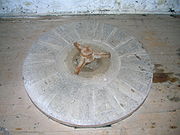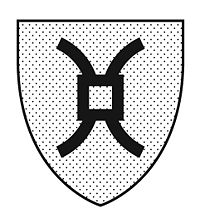
Rynd
Encyclopedia

Cross
A cross is a geometrical figure consisting of two lines or bars perpendicular to each other, dividing one or two of the lines in half. The lines usually run vertically and horizontally; if they run obliquely, the design is technically termed a saltire, although the arms of a saltire need not meet...
-shaped, for the turning ("runner") stone in a pair of millstone
Millstone
Millstones or mill stones are used in windmills and watermills, including tide mills, for grinding wheat or other grains.The type of stone most suitable for making millstones is a siliceous rock called burrstone , an open-textured, porous but tough, fine-grained sandstone, or a silicified,...
s. It is sometimes spelled millrynd or rynd.
The rind is affixed to the top of the main shaft or spindle and supports the entire weight of the runner stone, which can be as much as several tons. The rind is necessary because the grain is fed through the runner stone's central hole, so the spindle cannot be inserted through it like a cartwheel on an axle.
The face of a runner stone usually has a carved depression, called the "Spanish cross", to accommodate the millrind.
In heraldry

Heraldry
Heraldry is the profession, study, or art of creating, granting, and blazoning arms and ruling on questions of rank or protocol, as exercised by an officer of arms. Heraldry comes from Anglo-Norman herald, from the Germanic compound harja-waldaz, "army commander"...
charge
Charge (heraldry)
In heraldry, a charge is any emblem or device occupying the field of an escutcheon . This may be a geometric design or a symbolic representation of a person, animal, plant, object or other device...
, which takes its name from its form based on the physical object. An example is found in the arms of Sir William Saunsum, blazoned in a roll of arms
Roll of arms
A roll of arms is a collection of coats of arms, usually consisting of rows of painted pictures of shields, each shield accompanied by the name of the person bearing the arms...
temp. Edward II. The exact form differs in variety from that illustrated in the Saunsum arms to a form almost identical to the "cross recercelée"
Cercelée
Cercelée, or Sarcelly, is a term in heraldry. A cross cercelée is like an exaggerated cross moline and to a lesser extent like the anchored cross, with its forked tips curving around both ways, like a ram's horns. The form is also known as recercelée, for example by Boutell.-External links:* of...
, appearing as an exaggerated form of the "cross moline
Cross moline
The cross moline is a heraldic charge. It is so called because its shape resembles a millrind, moline being the Old French for a mill, the iron clamp of the upper millstone. It is very similar to one of the varieties of the "fer de moline" heraldic charge , the forked tips of which however...
", as borne by Ferre. The evidence for the cross recercelée variety being correctly seen as a fer de moline, confirmed by Boutell, is that the arms of Ferre were certainly designed to be canting arms
Canting arms
Canting arms are heraldic bearings that represent the bearer's name in a visual pun or rebus. The term cant came into the English language from Anglo-Norman cant, meaning song or singing, from Latin cantāre, and English cognates include canticle, chant, accent, incantation and recant.Canting arms –...
, and that the arms sculpted at Butley Priory
Butley Priory
Butley Priory was a medieval monastic house in Suffolk, England. Only the gatehouse remains today, which is very well preserved and displays stone sculpted heraldic escutcheons of its many benefactors, similar to the surviving gatehouse of Kirkham Priory in Yorkshire....
are indeed those of Guy Ferre (d.1323), who acquired the advowson
Advowson
Advowson is the right in English law of a patron to present or appoint a nominee to a vacant ecclesiastical benefice or church living, a process known as presentation. In effect this means the right to nominate a person to hold a church office in a parish...
of that place shortly before the gatehouse on which they appear was built. Planché
James Planche
James Robinson Planché was a British dramatist, antiquary and officer of arms. Over a period of approximately 60 years he wrote, adapted, or collaborated on 176 plays in a wide range of genres including extravaganza, farce, comedy, burletta, melodrama and opera...
states "the modes of representing the cross moline, or millrind, are endless".

